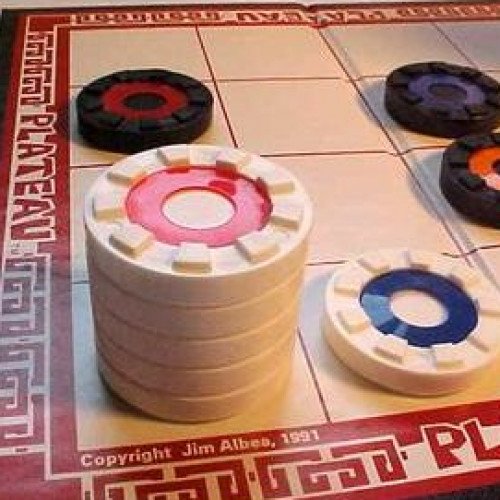PLATEAU VS REVERSI

PLATEAU
Plateau is a two-player abstract strategy board game invented by Jim Albea. The game was developed over a two-year period culminating in its present form on May 12, 1986. The original name for the game was Pinnacle, but it was discovered that an older board/card game had that name, so around 1989 the name was changed to Plateau. From the 1980s through the 1990s Plateau was played at Science Fiction conventions mostly in the Southeastern United States. From the 1990s to the present, the game is played live at an online game site and via email. In 1997 a computer implementation of the game was created which facilitates email play and has a computer robot. Onboarding is adding one new piece to the play. This new piece can be placed anywhere that doesn't directly harm an opposing piece. For instance, you can onboard to any blank square or on top of any of your own pieces. The majority of Plateau moves are onboards. Instead of Onboarding or Moving, a player can choose to spend his turn exchanging prisoners. Prisoners are exchanged using the point values of the pieces. A simple value-for-value system is used. Since the pieces range in value from 1 point (for the mute) to 21 points (for the Ace) there are usually several combinations and options available for the players. The player initiating the exchange selects the pieces he wishes to exchange. These pieces will all add up to some point value. The responding player then has four options depending on the point values of the prisoners that he holds.
Statistics for this Xoptio

REVERSI
Reversi is a strategy board game for two players, played on an 8×8 uncheckered board. It was invented in 1883. Othello, a variant with a change to the board's initial setup, was patented in 1971. There are sixty-four identical game pieces called disks (often spelled "discs"), which are light on one side and dark on the other. Players take turns placing disks on the board with their assigned color facing up. During a play, any disks of the opponent's color that are in a straight line and bounded by the disk just placed and another disk of the current player's color are turned over to the current player's color. The objective of the game is to have the majority of disks turned to display one's color when the last playable empty square is filled. Goro Hasegawa claims that the origin of Reversi/Othello dates back 5,000 years. However, there is solid evidence that a game similar to Reversi/Othello existed since the 19th century. Each of the disks' two sides corresponds to one player; they are referred to here as light and dark after the sides of Othello pieces, but any counters with distinctive faces are suitable. The game may for example be played with a chessboard and Scrabble pieces, with one player letters and the other backs. The historical version of Reversi starts with an empty board, and the first two moves made by each player are in the four central squares of the board. The players place their disks alternately with their colors facing up and no captures are made. A player may choose to not play both pieces on the same diagonal, different from the standard Othello opening. It is also possible to play variants of Reversi and Othello where the second player's second move may or must flip one of the opposite-colored disks (as variants closest to the normal games). For the specific game of Othello, the game begins with four disks placed in a square in the middle of the grid, two facing white-side-up, two dark-side-up, so that the same-colored disks are on a diagonal. Convention has this such that the dark-side-up disks are to the north-east and south-west (from both players' perspectives), though this is only marginally consequential: where sequential openings' memorization is preferred, such players benefit from this. The dark player moves first.